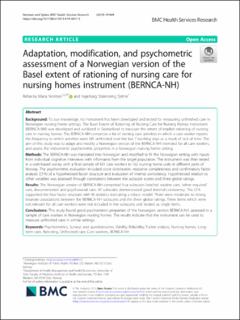| dc.contributor.author | Norman, Rebecka Maria | |
| dc.contributor.author | Sjetne, Ingeborg Strømseng | |
| dc.date.accessioned | 2020-02-21T11:29:04Z | |
| dc.date.available | 2020-02-21T11:29:04Z | |
| dc.date.created | 2019-12-17T14:43:42Z | |
| dc.date.issued | 2019 | |
| dc.identifier.issn | 1472-6963 | |
| dc.identifier.uri | https://hdl.handle.net/11250/2643212 | |
| dc.description.abstract | Background: To our knowledge, no instrument has been developed and tested for measuring unfinished care in Norwegian nursing home settings. The Basel Extent of Rationing of Nursing Care for Nursing Homes instrument (BERNCA-NH) was developed and validated in Switzerland to measure the extent of implicit rationing of nursing care in nursing homes. The BERNCA-NH comprises a list of nursing care activities in which a care worker reports the frequency to which activities were left unfinished over the last 7 working days as a result of lack of time. The aim of this study was to adapt and modify a Norwegian version of the BERNCA-NH intended for all care workers, and assess the instruments’ psychometric properties in a Norwegian nursing home setting.
Methods: The BERNCA-NH was translated into Norwegian and modified to fit the Norwegian setting with inputs from individual cognitive interviews with informants from the target population. The instrument was then tested in a web-based survey with a final sample of 931 care workers in 162 nursing home units in different parts of Norway. The psychometric evaluation included score distribution, response completeness and confirmatory factor
analysis (CFA) of a hypothesised factor structure and evaluation of internal consistency. Hypothesised relation to other variables was assessed through correlations between the subscale scores and three global ratings.
Results: The Norwegian version of BERNCA-NH comprised four subscales labelled: routine care, ‘when required’ care, documentation and psychosocial care. All subscales demonstrated good internal consistency. The CFA supported the four-factor structure with fit statistics indicating a robust model. There were moderate to strong bivariate associations between the BERNCA-NH subscales and the three global ratings. Three items which were
not relevant for all care workers were not included in the subscales and treated as single items.
Conclusions: This study found good psychometric properties of the Norwegian version BERNCA-NH, assessed in a sample of care workers in Norwegian nursing homes. The results indicate that the instrument can be used to measure unfinished care in similar settings.
Keywords: Psychometrics, Surveys and questionnaires, Validity, Reliability, Factor analysis, Nursing homes, Longterm care, Rationing, Unfinished care, Care workers, BERNCA-NH | en_US |
| dc.language.iso | eng | en_US |
| dc.rights | Navngivelse 4.0 Internasjonal | * |
| dc.rights.uri | http://creativecommons.org/licenses/by/4.0/deed.no | * |
| dc.subject | Psykometri | en_US |
| dc.subject | Ressursfordeling | en_US |
| dc.title | Adaptation, modification, and psychometric assessment of a Norwegian version of the Basel extent of rationing of nursing care for nursing homes instrument (BERNCA-NH) | en_US |
| dc.type | Peer reviewed | en_US |
| dc.type | Journal article | en_US |
| dc.description.version | publishedVersion | en_US |
| dc.source.volume | 19 | en_US |
| dc.source.journal | BMC Health Services Research | en_US |
| dc.source.issue | 969 | en_US |
| dc.identifier.doi | 10.1186/s12913-019-4817-3 | |
| dc.identifier.cristin | 1762098 | |
| cristin.unitcode | 230,0,0,0 | |
| cristin.unitname | Lovisenberg diakonale høgskole | |
| cristin.ispublished | true | |
| cristin.fulltext | postprint | |
| cristin.qualitycode | 2 | |

